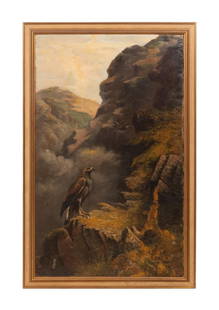
FAUVISM 20th C. Oil Manner of Alfred Maurer (unsigned),
Similar Sale History
View More Items in PaintingsRelated Paintings
More Items in Paintings
View MoreRecommended Art
View More





Item Details
Description
This amazing oil on canvas is a wonderful example of the best Fauvism art developed during the middle of the 20th Century. The dimensions are 25.25" x 18". About Fauvism by FauLouis Siegrest - White Houses, Danvillevism is about exuberant color and bold distortion of form and is considered the first «explosive 20th-century art movement. It is an Expressionist style that began in Paris. Its exponents rebelled against prevailing Academic Realism and focused, instead, on the artistÂs unique personal vision. Because of that change of focus, Fauvism represents an initial break with artistic traditions of the past. The movementÂs emphasis on expressive use of line, color, and brushwork helped liberate painting from the representational expectations that had dominated Western art since the Renaissance. Interest in Fauvism was relatively short lived, because of the introduction of Cubism and its emphasis on form rather than color. The influence of the Fauvist movement remains, however, in the artwork of many painters whose works are more driven by color more than geometric form. The term Fauve means _wild beast” in French, and was assigned contemptuously to a Ben Benn - Staten Island Landscapegroup of Post-Impressionist Parisian painters of the early 1900s who used color flamboyantly and sensuously. They even squeezed paint from the tube directly onto surfaces, which was shocking for that era. As an art movement, Fauvism is not easily definable because the description came from outsiders and not from any association of artists who formally agreed upon style or objectives or anything beyond the fact that color is its primary «languageÂ. Origin and Influences | Return to Top Major influences on Fauvism were Paul Gauguin (1848-1903), Vincent Van Gogh(1853-1890) and Georges Seurat (1859-1891). A comment written with modesty by Gauguin in a letter to a friend describes his commitment to the type of artistic innovation that, in turn, inspired Fauvism: _You have known for a long time what I wanted to establish: the right to dare everything. My capacities . . . have not led to any great result, but at least the machine is in motion. The public owes me nothing, since my pictorial work is only relatively good, but the painters who, today, are profiting from this freedom, do owe me something.” (Bowness 15) First exhibiting their work in 1905 in Paris at the Salon d'Automne, the original Fauvist group was composed of Henri Matisse (1869-1954), Georges Rouault (1871-1958), Maurice de Vlaminck (1876-1958), Andre Derain (1880-1954), Georges Braque (1882-1963) and Raoul Dufy (1877-1953). Describing work in this exhibition, critic Louis Vauxcelles coined the term Fauve to describe the chaos he perceived in their collective paintings. Contributing to the repeated description of the painters as _fauve” or wild was the frequent depiction by Rouault of prostitutes. Most of the French Fauvist painters in their original Salon exhibition were in their early twenties with the exception of Matisse, who at the age of 36 in 1905, was the oldest member of the group. Fauvisim in America | Return to Top American artists who were in Paris during the ascendancy of the Fauves, and whose paintings reflect the Fauves innovative use of color include Arthur Carles (1882-1952), Arthur Dove (1880-1946), Maurice Prendergast(1858-1924), Alfred Maurer (1868-1932), John Marin (1870-1953), Abraham Walkowitz (1878-1965), and Max Weber (1881-1961). In 1908, Alfred Stieglitz introduced work by Matisse to New Yorkers at his Photo-Secession Gallery, and most of the FaBob Thompson - Descent from the Cross uves from France exhibited there for several succeeding years. Many of them also exhibited at the 1913 Armory Show in New York. The introduction of Marsden Hartley (1877-1943) to Stieglitz was a turning point in HartleyÂs career whose work thereafter clearly reveals the influence of the European modernists. At the Photo-Secession Gallery, called #291 for its street address, Hartley was introduced to the works of Matisse, Picasso and Paul C_zanne (1839-1906). As a result his palette brightened to include the brilliant Fauve colors. Alfred H. Maurer is considered by some to be the first «American Modern. While living in Paris, he was a frequent visitor to the home of Gertrude and Leo Stein, whose weekly salons were gatherings of noted European and American intellectuals, especially artists and writers. Maurer created landscapes and still-lifes in the Fauvist style, using bold, exaggerated colors. He didn't earn critical acclaim for his work, however, and much of it he abandoned in 1914 when he fled France to escape the oncoming war. He returned to America and moved in with his father, working in a garret for the next seventeen years. Philadelphia artist Anne Estelle Rice (1879-1959) was living in Paris in 1905, and soon reflected a Fauvist approach in her brightly colored pictures of landscapes, coastal scenes, and portraits. Edwin Ambrose Webster (1869-1935) opened a Summer School of Painting in 1900 in Provincetown, Massachusetts where he became a pioneer of modernism until his death in the 1930s. Color was his primary concern, and much of his painting bordered on the Fauvist aesthetic. Raised in Provincetown, Louise Herreshoff(1876-196Arthur Dove - After image7) studied in France around the turn of the century, and then lived in New York. When she returned to Provincetown in 1911, she became the most avant-garde artist there, painting with a bright palette of unmodulated colors applied in thick brush strokes, work that shows the influence of Matisse and the Fauves. Although best known for his Precisionist work, Charles Sheeler (1883-1965) created a small number of Fauvist works depicting the countryside around Doylestown, Pennsylvania. There he spent weekends in a farmhouse retreat shared with fellow avant-garde painter Morton Livingston Schamberg (1881-1918) who also painted Fauves landscapes. SheelerÂs vivid impastoed expressive landscape, "Landscape with Waterfall," 1911 was included in the Armory Show of 1913. In the PhiladelphMont Sainte-Victoireia Enquirer for a January 1913 article on the upcoming exhibition Armory Show, Morton Schamberg offered an explanation of his Fauvist vision " It is not the business of the artist to imitate or represent nature. Art is creative, or rather, interpretiveó” Andrew Dasburg (1887-1979) traveled to Paris in 1909, where he visited the studio of Matisse and also encountered the work of Cezanne. Upon his return in 1911, he began, in Woodstock in the Catskills of New York, the «Sunflower ClubÂ, a local Fauve movement dedicated to using bright colors, contrary to the Tonalist style of Kenyon Cox and Birge Harrison, with whom he had studied at the Art Students League. Soon Catskill scenery appeared on daring coloristic canvases. DasburgÂs works were included in the New York Armory Show of 1913. The use of bold color by Pennsylvania artists including, Schamberg, Carles and Sheeler was a part of an American Fauvist counterpart to French Fauvism. Philadelphia artist George Biddle (1885-1973), who studied at the Philadelphia Academy in 1912 and 1913, captures the character of American Fauvism with use of brilliant color intensity in works such as his Landscape Cuba (1925). Artists from other parts of the country also reflected the influence of thSynchromist Nudee early Fauvists. Among them are Swedish born Sven Birger Sandzen (1871-1954) who became one of the most original and influential artists of Kansas. He combined Fauve color with the structural concerns of Paul Cezanne, and filled his canvases with expressionist blocks of pigment and rich impasto. Best known for richly painted Fauvist-inspired landscapes of the Smoky and Rocky Mountains, Sandzen is noted for his use of masses of paint, something like the manner of Vincent Van Gogh. Utah painter Alma Brockerman Wright (1875-1952) in 1902 went to Paris to study, returning in 1904. At first he used dark tonalities in his works, mainly portraits, but by the 1920s, he had abandoned that style in favor of the high colorism of a latter-day Fauvism, and became associated with the «Logan School of UtahÂ. Paul Burlin (1886-1969) was a participant in the 1913 Armory Show in New York City, where he also came under the influence of Robert Henri and Alfred Stieglitz. Traveling to Santa Fe, New Mexico, he was one of the first to bring modernism to the area, introducing Fauve color and expressionist distortion in his paintings of the landscape and Indian figures. Bob Thompson (1937-1966), a noted African-American artist from Kentucky, was not one of the original Fauves, but his work was greatly influenced by them, and he carried on their focus on color, as is evident in his use of planes of bright tones. FBirger Sandzen - Trees by a riverauvism, along with Expressionism and Cubism were all but unknown in the San Francisco Bay area until the 1920s. Canadian-American William Henry Clapp (1879-1954), who had studied in Paris between 1904 and 1908, was one of the earliest supporters of modernism in the area. He became a member of the Society of Six, the most significant group of avant-garde painters in the California Bay Area. «The Six consisted of Clapp, Selden Connor Gile (1872-1947), August Gay (1890-1948), Maurice Logan (1886-1977), Louis Siegriest (1899-1989), and Bernard von Eichman (1899-1970). Almost all had visited San FranciscoÂs Panama-Pacific International Exposition of 1915, where they were exposed to new art styles from around the world. Most of the works of these artists are notable for their rich raw colors of Post-Impressionism and Fauvism, and by around 1910 color had become the dominant component of their art. Other American artists whose work reflects the colorful influence of Matisse and the original Fauvists are: Ben Benn (1884-1983) of New York, Patrick Henry Bruce (1881-1937), James Daugherty (1887-1974), Charles Demuth (1883-1935), Arthur Burdett Jr. Frost(1887-1917), Stanton MacDonald-Wright (1890-1973), Morgan Russell (1886-1953), William Schumacher (1870-1931), and Marguerite Zorach (1887-1968).
Condition
Very good condition.
Buyer's Premium
- 23%
FAUVISM 20th C. Oil Manner of Alfred Maurer (unsigned),
Estimate $1,000 - $2,000
10 bidders are watching this item.
Shipping & Pickup Options
Item located in Boca Raton, FL, usSee Policy for Shipping
Payment

Related Searches
TOP









































































![[Custer, Little Big Horn] Eagle Elk, Oglala Sioux Warrior: “I was about 25 the summer we fought Long Hair and I still believed we could drive the white men from our country. I’m a little sad yet about that fight, although it was our finest victory.”](https://p1.liveauctioneers.com/7226/322253/173251540_1_x.jpg?height=310&quality=70&version=1710004847)